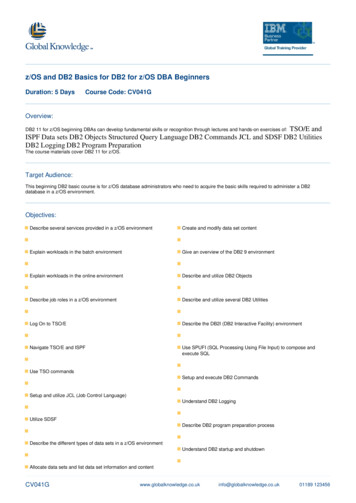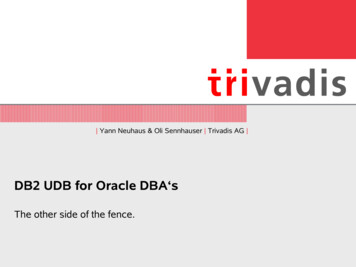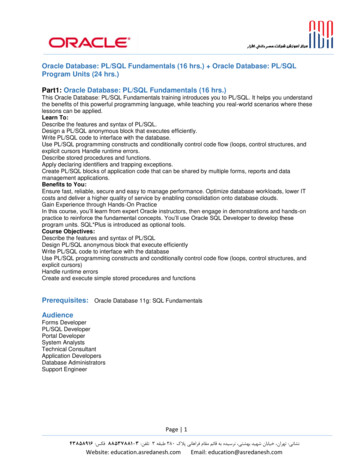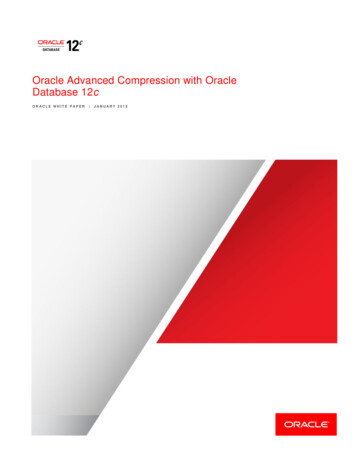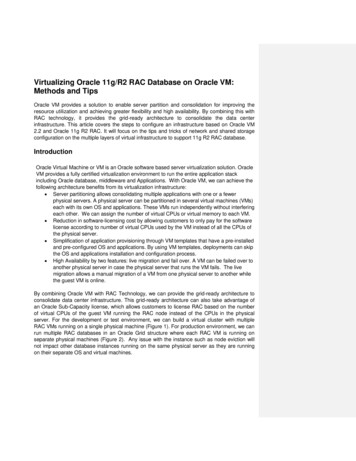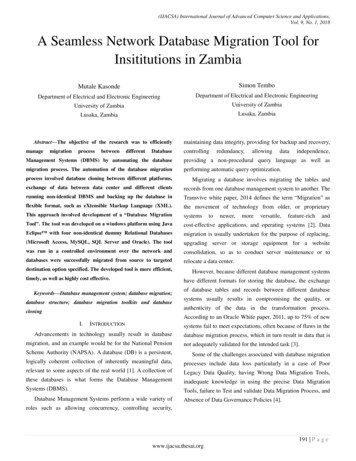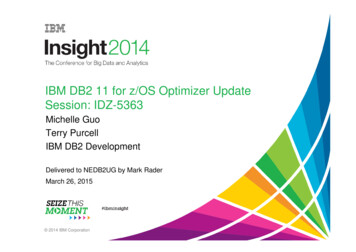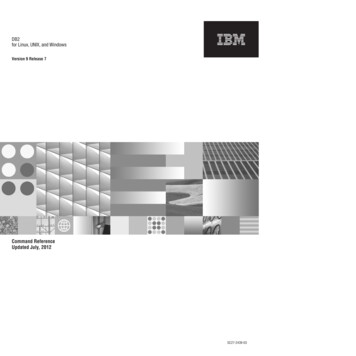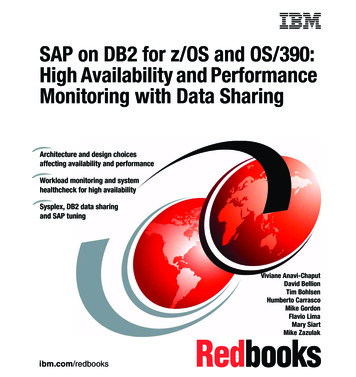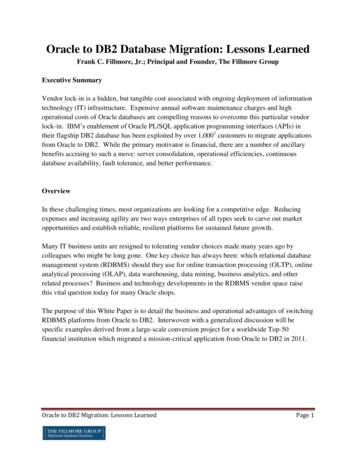
Transcription
Oracle to DB2 Database Migration: Lessons LearnedFrank C. Fillmore, Jr.; Principal and Founder, The Fillmore GroupExecutive SummaryVendor lock-in is a hidden, but tangible cost associated with ongoing deployment of informationtechnology (IT) infrastructure. Expensive annual software maintenance charges and highoperational costs of Oracle databases are compelling reasons to overcome this particular vendorlock-in. IBM’s enablement of Oracle PL/SQL application programming interfaces (APIs) intheir flagship DB2 database has been exploited by over 1,0001 customers to migrate applicationsfrom Oracle to DB2. While the primary motivator is financial, there are a number of ancillarybenefits accruing to such a move: server consolidation, operational efficiencies, continuousdatabase availability, fault tolerance, and better performance.OverviewIn these challenging times, most organizations are looking for a competitive edge. Reducingexpenses and increasing agility are two ways enterprises of all types seek to carve out marketopportunities and establish reliable, resilient platforms for sustained future growth.Many IT business units are resigned to tolerating vendor choices made many years ago bycolleagues who might be long gone. One key choice has always been: which relational databasemanagement system (RDBMS) should they use for online transaction processing (OLTP), onlineanalytical processing (OLAP), data warehousing, data mining, business analytics, and otherrelated processes? Business and technology developments in the RDBMS vendor space raisethis vital question today for many Oracle shops.The purpose of this White Paper is to detail the business and operational advantages of switchingRDBMS platforms from Oracle to DB2. Interwoven with a generalized discussion will bespecific examples derived from a large-scale conversion project for a worldwide Top-50financial institution which migrated a mission-critical application from Oracle to DB2 in 2011.Oracle to DB2 Migration: Lessons LearnedPage 1
Benefits of Migrating to DB2The primary benefit is financial: DB2 Advanced Enterprise Server Edition (AESE) can be aslow as 1/3 the cost of Oracle2.The next set of benefits are quantitative – DB2 required fewer of everything for this particularclient: Thirty-six(36) Sun servers reduced to four(4) POWER 770 servers3 for multipleapplication databases. Fewer servers resulted in fewer instances of DB2 to license. Twenty-seven(27) full-time equivalency (FTE) staff positions reduced to twelve(12) FTEfor all migrated databases. Surplus staff members were redeployed to other tasks.Additional benefits are qualitative: DB2 High Availability Disaster Recovery (HADR) provides database level failover atdata centers 14 miles apart; the customer impact of a database switchover betweendatacenters under load is 15 seconds, with an automatic cutover of applicationconnections. The client repeatedly had tried without success to implement Oracle RealApplication Clusters (RAC) with Data Guard to enable Oracle high availability. “The ability to switchover with efficiency is now a valuable triage tool that hassignificantly improved [our] mean time to recover from application anomalies. It is nowcustomary [for us] to initiate a datacenter database switch to attempt to clear customerimpacting locks, slowdowns, and hung threads that previously required a restart duringoff hours. Database switching in this manner was unanticipated and noteworthy.”4 IBM transaction-level Q Replication provides tertiary failover 500 miles fromprimary/secondary data centers. In 2010 Oracle block-level replication had transmittedcorrupted log records to all failover sites. Database recovery took days resulting in amajor, high-visibility customer-facing application outage. DB2 on POWER delivers up to 3 times the performance per core of Oracle database onSPARC5. The client anecdotally indicated that IBM DB2 technical support was more responsiveand able to address and resolve issues more quickly than did Oracle.Oracle to DB2 Migration: Lessons LearnedPage 2
IBM has a series of tools to evaluate and enable a migration from Oracle to DB2: Migration Enablement Evaluation Tool (MEET) to make a detailed determination of anexisting Oracle database’s compatibility with DB26. Business Value Assessment (BVA) financial tool to compare current Oracle licensingcosts to equivalent DB2 licensing costs. IBM Data Movement Tool (IDMT) to extract data and database objects from an Oracledatabase and load them into DB27.Contact your IBM representative or IBM Business Partner for additional information regardingthese tools and to receive a free review of your Oracle database and workload suitability formigration to DB2.Oracle to DB2 Migration: Lessons LearnedPage 3
Key Players in the Migration ProcessOnce a choice has been made to consider migrating from Oracle to DB2, who should beinvolved? And when? The following table lists the various contributors and when theyparticipate in the process.LOB executivesIT executivesData/Application ArchitectsDatabase AdministratorsSystems AdministratorsApplication developersEnd usersDecision Planning/Design Implementation TestingXXXXXXXXXXXXXXXIT and line-of-business (LOB) executives must collaborate on determining the overall value tothe organization of migrating from Oracle, the impact a major infrastructure change will have onnew feature/function application development delivery schedules, and – most importantly – thereturn on investment of choosing to move to DB2. Commitment from both IT and LOBexecutives is crucial to the success of such an undertaking.Data and application architects are the only role which spans all phases of a migration project. Itis important that architects provide to senior executives validation that a migration is technicallyfeasible, then shepherd the process from a “go” decision to production cutover and beyond.Some might argue that database administrators (DBAs) should be included in the decision tomigrate and application developers in the planning. One practical aspect of this process thatmust be considered is that Oracle DBAs and developers will be asked to make a major changethat some might deem to be detrimental to their careers. Most IT professionals take pride in theirskills and develop a loyalty to the products with which they have worked for years. In severalinstances where clients have contemplated a migration from Oracle to DB2, the in-the-trenchesinfluencers have not unreasonably focused on their perceived career interests rather than thegoals and objectives of their employer. Better to make the decision on the financial andtechnical merits and include other stakeholders as the need arises. An alternative approach isoffer financial incentives and retention bonuses to key technical staff members. In this way theycan share in the benefits of the migration and mitigate any perceived risk.Oracle to DB2 Migration: Lessons LearnedPage 4
Planning and Designing the Migration8It is prudent to view changing database software within the larger context of an organization’s ITinfrastructure. While a client could just migrate from Oracle to DB2 and keep all otherinfrastructure components (e.g. server hardware, operating system, storage, networking,facilities, etc.), the current state of those components such as capacity, projected useful life, andother factors should be considered as well. In the case of the Top-50 financial institution, theychanged virtually every aspect of their IT infrastructure. There were two reasons: most of theexisting infrastructure was outdated and they wanted to exploit synergies between IBM hardwareand middleware. For example: DB2 can exploit an AIX 16 MB page size on IBM POWERsystems; for memory-intensive database applications, this can dramatically improveperformance. New infrastructure also insulates existing application workloads from themigration process. It is important to note however, that migrating from Oracle to DB2 does notrequire any other changes if existing hardware and operating systems are compliant with DB2prerequisites.Design of the new database servers should incorporate existing service-level agreements (SLAs)for OLTP, business analytics, and other database-dependant processes. They should also sustainprojected growth in demand and capacity, whether organic or through mergers and acquisitions.IBM’s Smart Analytics System (ISAS)9 is a DB2 database platform which delivers optimized,integrated hardware, software, and storage. ISAS mitigates the risk of incorrectly forecastingfuture database utilization by providing preconfigured units of additional capacity for allcomponents.Application and Data MigrationWhile up to 98% of a typical client’s Oracle PL/SQL workload will run unmodified against aDB2 database10, application source code will need to be managed through the migration processto accommodate changes for the other 2% of PL/SQL which is not supported by the DB2 APIs to improve performance to incorporate functional enhancements, comply with legal requirements, and meet otherbusiness objectives that arise during the migration.The migration from one database platform to another doesn’t occur in a vacuum and a rapidlychanging competitive and regulatory environment won’t permit a code “freeze”. Applicationsource code, RDBMS Data Definition Language (DDL), batch scripts, and other artifacts shouldbe managed by repository tools that support versioning and multiple user check-in/check-outaccess.Oracle to DB2 Migration: Lessons LearnedPage 5
Data migration is enabled by the IDMT referenced earlier. Through a command line interface orGUI, the no-cost IDMT automates the extraction of Oracle data and DDL and generates DB2LOAD utility scripts. The Top-50 financial institution used IDMT for all of its migrationactivity. IDMT, by its nature, is a batch process and must be benchmarked. The elapsed time ofextract and load for one of the client’s multi-terabyte OLTP databases was measured atapproximately five days. Sustaining a five-day outage for this particular application was notfeasible, so they used a combination of IDMT and IBM’s Q Replication software (to captureOracle transactions while IDMT was running) to significantly reduce the outage window11.Testing and ValidationAn organization undertaking an Oracle to DB2 migration would be wise to set up multipleenvironments for testing.1. a Development (DEV) environment for unit testing2. a Quality Assurance (QA) environment for functional validation and integration testing3. a Performance (PERF) environment for volume testing4. a Production (PROD) environment as the target for final production cutover.For smaller migrations or to reduce expenses, DEV/QA and/or PERF/PROD can be combined.Only the PERF and PROD environments need to have sufficient processing and storage capacityto accommodate a production workload.Application developers and end users should be enlisted to define test plans and test cases.These should include both daily transaction processing as well as important business cycles (i.e.month-end, period closing, and so forth). Testing batch jobs is as important as OLTP, but manybatch processes that invoke Oracle commands and utilities will undergo significant changes. Itwill be important to analyze these internal IT processes in light of DB2 feature/functionality todetermine if these batch jobs continue to meet a business objective. In some cases DB2 databasemaintenance might produce significant savings in terms of runtime and administrative effort.The client noted an exceptional reduction of time and effort when using DB2 backup utilitiescompared to the steps necessary to backup an Oracle database.QA testing should be used to verify exception and error handling and validate key numericalvalues such as row counts and total amounts (e.g. account balances).Oracle to DB2 Migration: Lessons LearnedPage 6
PERF testing is vitally important because, although DB2 supports PL/SQL syntax, it might notperform the same way as it natively does in Oracle12 – at least without tuning. There are avariety of ways to mitigate variations in performance through: DDL changes (e.g. indexes) exploitation of DB2 features such as range partitioning, materialized query tables(MQTs), multi-dimensional clustering (MDC) as a last resort, rewriting the SQL itself.PERF test cases should include expected spikes in processing related to time-of-day and seasonaland business cycles. As discussed earlier, the migration process itself should be benchmarked todetermine if it will successfully complete within an acceptable application outage window.Skills EnablementMany of an organization’s technical staff members will be new to DB2. While Oracle and DB2SQL APIs will work the same (98% of the time) there are significant differences in commands,utilities, terminology, and underlying structure. Providing formal training in DB2 for DBAs andapplication developers early in the migration process will pay enormous dividends. It will alsodemonstrate to staff members management’s commitment to enhancing their technicalcapabilities. There are a variety of self-study and classroom courses specifically designed tohelp the Oracle specialist become familiar and comfortable with DB2. An example is IBMcourse code CL720 “Oracle to DB2 Enablement Workshop”13. There are also a number of othercourses, books, conferences, and seminars on specialized topics such as DB2 design, tuning,backup/recovery, tools and utilities, high availability, etc. IBM also offers free how-to manualsknown as Redbooks14. These are typically written by IBM specialists and Business Partnerscovering a particular technical topic at great depth - usually in the form of a case study detailingthe implementation of a technology to solve a specific business requirement.The Big DayAfter a few months of meticulous planning and hard work – the Top-50 financial institutioncompleted their first database cutover from Oracle to DB2, from “go” decision to live customerfacing production, in less than 3 months – the big day arrives for your organization. The clienthad a dedicated project manager who maintained a detailed timeline of all of the activities of thevarious groups involved: systems administrators, DBAs, developers, operations, security, and thelike. They arranged to have key personnel and IBM subject matter experts (SMEs) availableonsite and on-call in case an unexpected problem cropped up. The timeline included periodiccheckpoints and fallback plans. In addition, they had implemented automated monitoring forOracle to DB2 Migration: Lessons LearnedPage 7
both business-as-usual (BAU) and migration processing. Of the four major Oracle to DB2migrations undertaken by this client in 2011, all completed successfully without customerimpact.We Did It! Now what?After a suitable celebration – scheduled after a few important business cycles are processedwithout incident – what’s next? Join together with other DB2 shops to share experiences andengage in an ongoing dialogue to fully exploit your new investment. Venues to do this include Regional DB2 Users Groups15 International DB2 Users Group (IDUG)16 IBM Information on Demand Conference (IOD)17Users groups and conferences provide attendees with substantive learning opportunities onspecific topics that are important to your organization. Most users groups meet quarterly and theIDUG and IOD conferences are held annually in different geographies around the world.Oracle to DB2 Migration: Lessons LearnedPage 8
Endnotes1Since 2009 (ibm.com/facts).Cost based on publicly avail U.S. pricing info as of 4/3/2012 for IBM DB2 Advanced Enterprise Server Edition Oracle Database Enterprise Edition software w/added priced products/features to provide comparablefunctionality. IBM prices exclude applicable taxes, and are subject to change by IBM without notice. IBM: assumes100 Processor Value Units. Oracle: assumes 1.0 processor core factor. Both including Y1 maintenance/support.3Includes DB2 HADR secondary.4Senior client architect who guided the migration.5www.tpc.org (http://www.tpc.org) as of 4/3/2012 [IBM Power 780 (3 x 64 C)(24 Ch/192 C/768 Th); 10,366,254tpmC; 1.38/tpmC; avail 10/13/10 v. Oracle SPARC SuperCluster w/T3-4 Servers (27 x 64 C)(108 Ch/1728 C/13824Th); 30,249,688 tpmC; 1.01/tpmC; avail 6/1/11]. TPC-C is a trademark of Transaction Performance ProcessingCouncil. www.sap.com/solutions/benchmark/ (http://www.sap.com/solutions/benchmark/) as of 4/3/2012 [IBMPower 795 (32 P/256 C/1024 Th); 126063 users/2-tier SAP ERP 6.0 pack4/AIX 7.1 DB2 9.7; cert 2010046 v. OracleSPARC Enterprise Server M9000 (64 P/256 C/512 Th); 39100 users/2-tier SAP ERP 6.0/Solaris 10, Oracle 10g; cert2008042]. SAP is registered trademark of SAP AG in Germany and in several other countries. Any pricecomparisons made by IBM are not based on the specific benchmarks listed 6/wwhelp/wwhimpl/java/html/wwhelp.htm?href rary/techarticle/dm-0906datamovement8Much of this and some succeeding sections were derived from "Successfully Migrating From A Sun/Solaris/OracleStack To IBM p770/AIX/DB2 9.7" Session Number 1495 at the IBM Information on Demand Conference held in LasVegas, NV October 2012 presented by Jeff Richardson of IBM. Jeff was the lead IBM architect of the specificmigration discussed in this White ere/smart-analytics-system/10Based on internal IBM tests and MEET analysis of customer PL/SQL workloads.11Details on this approach for the specific migration discussed in this White Paper can be found in “Zero OutageOracle to DB2 Migrations” presented at the International DB2 Users Group (www.idug.org) held in Denver, CO May2012 presented by the author.12Remember, Oracle and DB2 use vastly different SQL optimizer technologies.13Details can be found at 15http://www.idug.org/p/cm/ld/fid tware/data/2012-conference/2Oracle to DB2 Migration: Lessons LearnedPage 9
Oracle to DB2 Migration: Lessons Learned Page 1 Oracle to DB2 Database Migration: Lessons Learned . migrate and application developers in the planning. One practical aspect of this process that . facilities, etc.), the current state of those components such as capacity, projected useful
